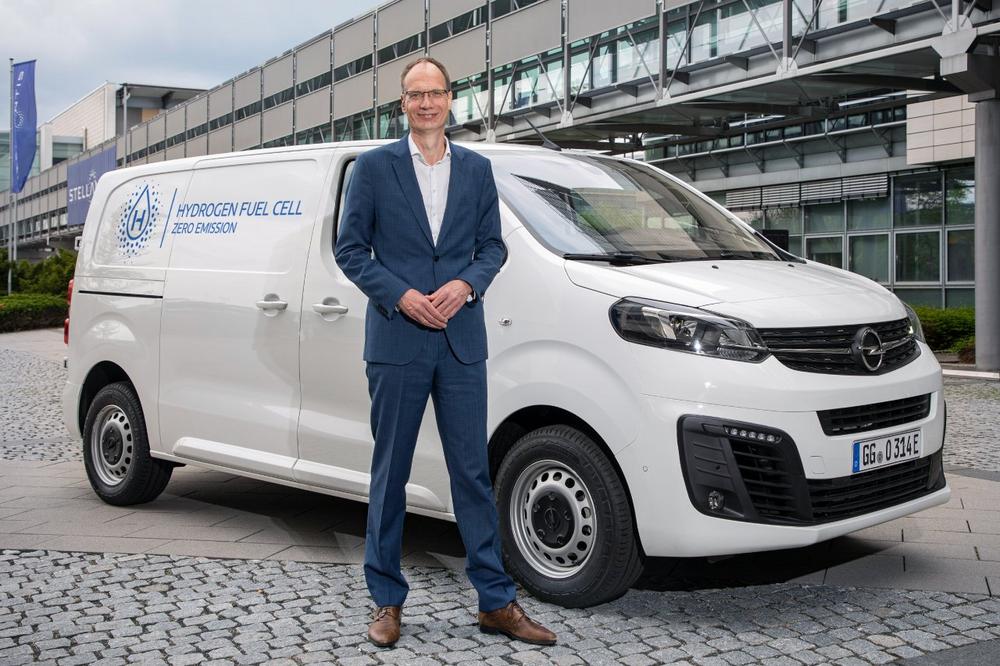- No compromises: Up to 6.1 m3 cargo volume, 3-minute refuelling, 400 km range,
- Vivaro-e basis: Fuel cell system in engine bay, hydrogen tanks replace battery
- Smart design: Plug-in fuel cell concept benefits packaging, performance and durability
- Made in Germany: Vivaro-e HYDROGEN will be assembled in Rüsselsheim
Opel today unveiled a new electrically powered light commercial vehicle that will enable zero emission mobility for customers who need to refuel within minutes. The Opel Vivaro-e HYDROGEN is a plug-in fuel cell electric vehicle (FCEV) with up to 6.1 cubic metres of cargo capacity (the same as the diesel or battery electric versions of the Vivaro) that needs only three minutes to refuel with hydrogen – about the same time needed to fill up a conventional diesel or petrol car. The range is more than 400 kilometres (WLTP1). Opel will offer the Vivaro-e HYDROGEN in lengths M and L (4.95 and 5.30 metres). The company plans to start delivering the first vehicles to fleet customers in the autumn.
“Hydrogen could be the central element of an integrated and efficient energy system of the future, free of fossil fuels”, says Opel CEO, Michael Lohscheller. “We have more than 20 years of experience in hydrogen fuel cell vehicle technology. There is hardly another propulsion system in the world that offers the combination of zero emissions, long driving range and only three minutes refuelling time.”
Efficient, durable, space-saving: Benefits of plug-in fuel cell concept
The new fuel cell electric vehicle (FCEV) is based on the existing battery electric Opel Vivaro-e with two sliding side-doors. The plug-in fuel cell concept of the Vivaro-e HYDROGEN enables the integration of the whole fuel cell system with the existing traction motor under the bonnet of the production vehicle. In addition, the battery of the Vivaro-e BEV (battery electric vehicle) is replaced by three 700 bar hydrogen tanks. The carbon-fibre cylinders can be filled in just three minutes, giving a range of more than 400 km. Thanks to the smart packaging, the battery electric version thus becomes a fuel cell electric LCV without any modifications to the body and with no impact on the 5.3 to 6.1 m3 of cargo space, while the payload increases to 1,100 kg.
The Opel Vivaro-e HYDROGEN with its 45 kW fuel cell is capable of generating enough power for continuous highway driving, while the 10.5 kWh lithium-ion battery located under the front seats provides dynamic peak power when required, for example, at start-up and under acceleration. Since the battery covers power needs in such situations, the fuel cell can run at optimum operating conditions. The battery also enables regenerative braking, while the plug-in capability offers the opportunity to recharge the battery externally if necessary, e.g. at a charging station, providing 50 km of pure battery electric range.
The Vivaro-e HYDROGEN will be produced by Opel Special Vehicles (OSV) in Rüsselsheim. The global “Competence Centre for Hydrogen and Fuel Cells” of the parent company Stellantis is also located in Opel’s hometown.
The Vivaro-e HYDROGEN complements the Vivaro-e and the Combo-e as the newest member of Opel’s all-electric LCV family. The next new model, the new Movano-e, will also arrive in 2021, meaning that the brand’s entire light commercial vehicle portfolio will be electric by the end of this year. Opel will offer an electrified version of every passenger car and LCV model by 2024.
[1] Range determined according to WLTP test procedure methodology (R (EC) No. 715/2007, R (EU) No. 2017/1151).
Opel Automobile GmbH
Bahnhofsplatz
65423 Rüsselsheim
Telefon: +49 (6142) 7-70
Telefax: +49 (6142) 77-8409
http://de-media.opel.com/de
Assistant Manager International Product & Technology Communications
Telefon: +49 (6142) 69-21576
E-Mail: jan-philipp.kress@stellantis.com
Communications, Manager International Product
Telefon: +49 (6142) 69-22084
E-Mail: colin.yong@stellantis.com
![]()

